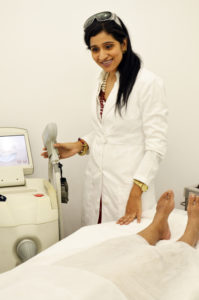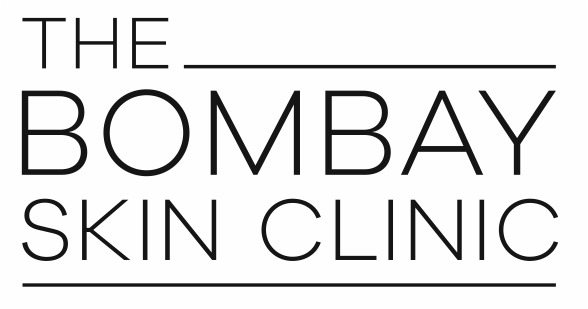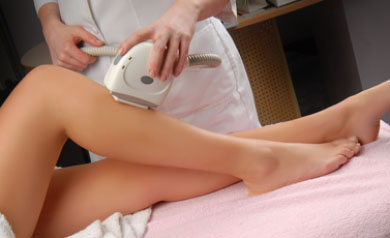Overview | Types of laser hair removal | Advantages of laser | Self-care tips for hair removal | How can dermatologist can help
We all love to be well-groomed as this increases our confidence in the outside world. While we want a thick mane of hair on our head, having excess body hair can be upsetting. Many people opt for laser hair removal treatment options to take care of this excess growth.
There is a condition known as hirsutism, which is the growth of excess, thick body hair on areas that are normally not hairy. While hirsutism is more common in women, Johns Hopkins Medicine notes that it can also affect men. Yet, all hair growth should not be confused with this condition. Let me answer some frequently asked questions on excess hair growth and hair removal treatment options including laser hair removal that my patients have often put across to me.
What are the types of laser hair removal?
Laser hair removal is an extremely popular hair removal treatment. Let me take you through the different options for laser hair removal, which is one of the best options for hair removal for Indian skin.
- Diode laser – The diode laser treatment is a US FDA-approved Vikini diode laser for permanent hair reduction. The beam emitted is 810 nm. One of the main advantages of the diode laser is that it is suited to darker skin tones due to its longer wavelength. It is suited for people with types of skin 1 to 6. I want to also add here that the diode laser really is a gold standard for hair removal.
- ND YAG laser – ND YAG is referred to by its short form as the real name, which is neodymium-doped yttrium aluminum garnet, would be tough to call. ND YAG is approved by the FDA. The beam emitted is 1064 nm. Looking at the advantages, the first one is that ND YAG laser hair removal treatment is suited to all skin types. ND YAG can be successfully used to remove gray, blue, and black tattoos. It also works well to treat wrinkled skin.
- IPL – IPL stands for intense pulsed light. IPL targets the root of the hair and damages it to prevent new hair growth. The IPL treatment is quicker than laser and can take only around 15 minutes for larger areas on the body. Finally, over time, the overall hair growth is reduced with multiple treatments. The gap between treatments will also increase, thus making it more comfortable for you.
- Alexandrite laser – This is a special type of laser that emits light of high energy through an alexandrite crystal. The beam emitted is 755 nm. Alexandrite laser can be used to treat a variety of skin conditions including age spots, tattoo removal, and spider veins. It is commonly used in hair removal and is suited to all skin types.
- Combined laser treatment – Another option that can be considered is the combined laser treatment for hair removal. In this method, all three wavelengths of 810 nm , 755 nm, and 1064 nm come through one device. This advanced technology can treat all skin types and also works great on very fine hair.
Which areas are usually affected by excessive hair growth?
There are follicles of hair all over the body except on the lips, under the feet and on the palms of your hands. Women can also get light hair on their upper lip and chin while men get excessive growth in these areas. The tops of shoulders, back, feet, and underarms can have embarrassingly large growths of hair.
The good news is that laser hair removal can work on almost any part of the body. This includes the face, arms, legs, back, feet, and even the sensitive bikini line. It is a safe and quick form of hair removal. This is especially true for people suffering from ingrowths that lead to boils and infection. These black dots are often visible on the arms and legs even after painful waxing. What’s more is that your skin may actually be sensitive to hot wax.

The only thing that varies between patients is the duration of the treatment as this depends on the areas that need hair removal.
On a personal note, I recommend avoiding laser treatment on the area around the eyes.
What can you expect after a laser hair removal treatment?
Laser hair removal might leave your skin feeling slightly sunburned but this is normal. The dermatologist will recommend moisturizers that will help cool your skin. Over the next month, the area that was treated will see hair fall off. Your next session will happen in one month to six weeks. These sessions will continue until you achieve permanent results.
What are some pre-treatment instructions for laser hair removal?
Your dermatologist will provide specific instructions that need to be followed to ensure that you get the best out of your laser hair removal treatment. Some common instructions include:
- Shave the area to be treated before going to the clinic
- Avoid direct exposure to sunlight for at least a month before your treatment
- Avoid tanning beds
- Do inform your doctor if you have ever had cold sores
In addition, the Stanford Health Care cautions women who are pregnant or who think they might be pregnant to avoid laser treatment.
What are the benefits of a laser hair removal procedure?
Laser hair removal is truly versatile and can be used to treat almost any part of the body including the face, arm, underarms, leg, and the bikini line. Here are some of the major advantages of laser hair removal that are truly worth noting.

- Accuracy of treatment – Laser hair removal is highly accurate and can work on thick, rough hairs while not harming the sensitive skin around.
- Speed of procedure – Laser treatment works fast. In fact, it can treat small surfaces such as the skin above your lip in under one minute and larger surfaces such as the back in just one hour.
- Wide suitability – Laser treatment is suited to all skin tones. The only requirement is that the hair needs to be dark enough to be picked up by the laser. There is no harmful impact on pigmented skin.
What are some myths on laser hair removal?
There are many myths on laser hair removal due to which many patients are hesitant to seek this treatment. Let’s take a look at some of them:
- Myth 1: Laser hair removal causes burns – Truth: The fact is that if done with a professional dermatologist, laser hair removal is a safe and efficient procedure. It will not cause you to get burns. Do talk to your dermatologist about what laser options are suited to you.
- Myth 2: Laser hair removal causes cancer – Truth: This is another myth that I always tell my patients not to worry about. There is absolutely no scientific evidence that laser hair removal leads to cancer.
- Myth 3: Laser hair removal is costly – Truth: A single session of waxing can seem to cost less but actually turns out to be much more over the course of your lifetime. On the other hand, while a single session of laser treatment might seem costly, the results are more permanent and you also save on the time spent repeatedly visiting the parlor.
- Myth 4: Only women do laser hair removal – Truth: These days even men opt for laser hair removal. The preferred spots for men to remove hair include their neck, chest, and back.
What are some self-care tips for hair removal?
There are many ways in which you can manage to remove excess or unwanted body hair. Some of the common methods are:
- Hair removal creams – There are many hair removal creams or gels available in the market. Do be wary as these can cause skin irritation. I advise you to do a patch test first.
- Waxing – Waxing is one of the most common methods of hair removal. It is usually done with hot wax. This method is quite painful and can leave your skin sore and red.
- Tweezing and shaving – Tweezing or plucking hair can be conveniently done on smaller areas such as the eyebrows but is impractical for larger surfaces such as the legs and back. Shaving is popular but the hair grows back quickly and leaves your skin feeling rough. The National Health Service UK also notes that patients may take medicines to slow down facial hair growth; however, I strongly advise you to ask your doctor first and never self-medicate.
There is another method known as electrolysis. In this method of hair removal, an electric current is used to destroy a hair follicle to prevent new hair growth. Several sessions are required for electrolysis treatment to be completed and there is a degree of pain involved.
These hair removal methods can be practiced safely though they do not give permanent results. I would like to mention that there is no evidence that they increase hair growth either. Yet, if you are looking for a long-term approach to hair removal, I would recommend laser treatment for the ease that it provides as opposed to epilators.
How is hair removal treatment different for men and women?
Everyone gets body hair. Yet, what gender you belong to influences your take on it. An increasing number of men are opting for hair removal for a number of reasons including hygiene and grooming. Men who play active sports also often want excess body hair removed. Men often opt for permanent hair removal through laser treatments for their back, chest, stomach, and genital areas. Men opt to wax away the hair on smaller patches of skin such as the ears and for eyebrow shaping.
When it comes to hair removal in women, the most treatment options include tweezing, shaving, waxing, electrolysis, and laser. Laser is the most effective for permanent hair reduction with minimal discomfort and the best results.
What are the symptoms of excessive hair growth?
Hirsutism normally shows up in women in areas where they would not normally develop thick hair. This includes the face, back, chest, around the navel, and inner region of the thighs. Hirsutism might also be accompanied by other signs such as acne, reduced breast size, and an onset of baldness.
How can a dermatologist help with hair removal?
A hair removal treatment is best carried out by a trained dermatologist. Going to a dermatologist will get you access to the best in clinical research and laser treatment technology. Please stay clear of salons that claim to be hair specialists in Mumbai but actually do not have the necessary qualification to handle equipment like lasers. Remember that it is all right to ask to see the qualifications of the dermatologist or technician treating you; after all, it is your skin.
Also, a dermatologist will be able to come up with innovative solutions for your skin type. I personally spend time and ask detailed questions to each of my patients so that I get a complete understanding of their medical history before recommending the best hair removal treatment suited to them. While doing hair removal treatment in my clinic, the settings that are used for removing the hair are individualized per client and also per area to give the best results. Hence the understanding of the laser is very important. And, this type of understanding only comes with a trained dermatologist.
Closing thoughts
Hair growth on the body can upset you and cause much discomfort while grooming. But now with advancements in laser technology, excessive hair growth is truly a thing of the past. This is indeed good news for anyone impacted by conditions such as hirsutism. I encourage you to come forward and get a skin and hair evaluation done. Say goodbye to the painful treatments such as waxing and tweezing that honestly do not offer any kind of long-lasting solution.
Finally, like any other medical treatment, laser hair removal too should be performed by skilled hands only. Your skin is a part of your natural beauty and therefore, only a qualified dermatologist should be allowed to treat it.
References
- Johns Hopkins Medicine – https://www.hopkinsmedicine.org/health/conditions-and-diseases/excessive-hairiness-hirsutism
- National Health Service UK – https://www.nhs.uk/conditions/hirsutism/
- Stanford Health Care – https://stanfordhealthcare.org/medical-conditions/skin-hair-and-nails/unwanted-hair.html


 Dr. Batul Patel is a celebrity dermatologist and the medical director of The Bombay Skin Clinic an award winning clinic located in South Mumbai & Bandra. She is a passionate and dedicated dermatologist with expertise in all fields of dermatology, trichology and aesthetic dermatology. She has been practicing for more than a decade. Her range of expertise include emsculpt NEO, coolsculpting, fillers, acne treatment, lasers, skin rejuvenation, hair loss, hair transplant, PRP & pigmentation treatments.
Dr. Batul Patel is a celebrity dermatologist and the medical director of The Bombay Skin Clinic an award winning clinic located in South Mumbai & Bandra. She is a passionate and dedicated dermatologist with expertise in all fields of dermatology, trichology and aesthetic dermatology. She has been practicing for more than a decade. Her range of expertise include emsculpt NEO, coolsculpting, fillers, acne treatment, lasers, skin rejuvenation, hair loss, hair transplant, PRP & pigmentation treatments.